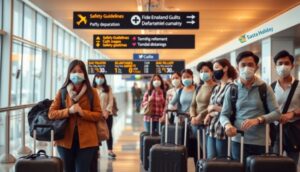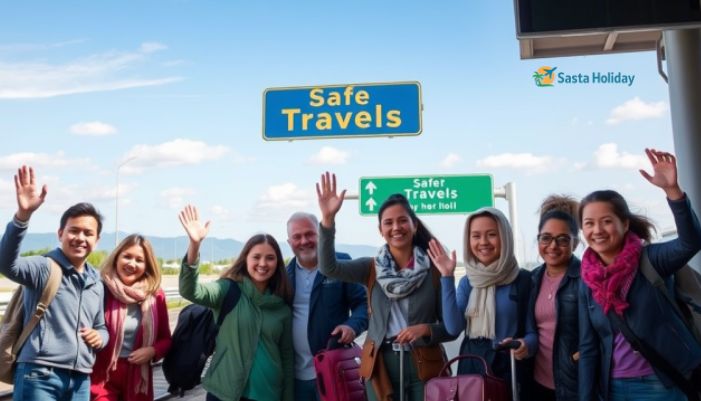You’ve probably heard someone say “safe travels” before. Maybe it was your friend, your mom, or even a stranger at the airport.
But what does it really mean?
At first, it sounds simple. Just two words. But those two words say a lot. They show care. They show love. They show that someone is thinking of you and hoping you make it safely to where you’re going.
In this post, we’ll break down what safe travels really means. We’ll look at where the phrase comes from, why people say it, and when it’s best to use it. We’ll also look at how these two little words make people feel safe, seen, and loved.
What Is the Meaning of “Safe Travels”?

“Safe travels” is a way to wish someone a safe trip. It means, “I hope nothing bad happens on your journey.”
It can also mean:
-
I hope your flight is smooth.
-
I hope your car doesn’t break down.
-
I hope you don’t get sick.
-
I hope you come back happy and safe.
Even though it’s short, this phrase shows that you care. You want the person to have a good and easy trip. It’s a warm way to say goodbye.
Why Do People Say “Safe Travels”?
People say “safe travels” because they want the best for someone who is leaving. It’s a kind way to send someone off.
1. It’s a Sign of Care
When someone says it, they are showing they care. You don’t say “safe travels” to just anyone. You say it to friends, family, coworkers—or even kind strangers.
2. It Gives Comfort
Travel can be stressful. Delays happen. Accidents can happen. Saying “safe travels” helps people feel supported and less alone.
3. It’s a Tradition
Wishing someone a good trip has been around for a long time. Different cultures have their own ways of doing it (we’ll talk about that next). It’s a tradition that brings people closer together.
Where Did the Phrase Come From?
“Safe travels” doesn’t have one clear starting point. But people have always wanted to wish others well before a journey.
Travel Was Dangerous in the Past
Hundreds of years ago, travel was risky. There were no cars, planes, or GPS. Roads were rough. People could get lost or hurt. So, before someone left, others would wish them safety.
These good wishes became phrases like:
-
“Bon voyage” (French)
-
“Viaje seguro” (Spanish)
-
“Gute Reise” (German)
-
“Buon viaggio” (Italian)
Today, we use “safe travels” to do the same thing—just in plain, modern English.
When to Say “Safe Travels”
You can say it any time someone is about to go somewhere. It works for big trips or small ones.
Examples of When to Use It:
-
Your friend is flying overseas.
-
Your sibling is going on a road trip.
-
A coworker is heading to a conference.
-
Someone is leaving your house after a visit.
It’s short and polite. It works well in person, in texts, emails, or even in social media comments.
Other Ways to Say “Safe Travels”
Sometimes, you may want to change it up. Here are some other ways to wish someone a safe trip:
-
“Travel safe!”
-
“Have a good trip!”
-
“Hope you get there safe.”
-
“Wishing you smooth travels.”
-
“Take care on the road.”
-
“Drive safe!”
-
“Godspeed.” (a more formal or old-fashioned version)
All of these say the same thing—you care, and you hope they’re okay.
Why “Safe Travels” Is Still Important Today
Even though travel is easier today, it’s not always safe. Planes get delayed. Roads can be dangerous. And things can still go wrong.
That’s why people still say “safe travels.” It helps us feel connected. It shows we care, even when we can’t go with them.
Small Words, Big Feelings
Saying “safe travels” only takes a second. But it can mean a lot. It can make someone feel loved, remembered, and protected. It’s a kind and human thing to say.
How “Safe Travels” Makes a Difference

1. It Strengthens Relationships
Wishing someone well makes your connection stronger. It shows that you’re thinking of them and that you want the best for them.
2. It Helps with Stress
Travel can be hard. If someone is nervous about flying or driving, hearing “safe travels” can calm their nerves.
3. It Adds a Nice Touch
In hotels, airports, and travel companies, saying “safe travels” is part of good service. It makes people feel welcome and cared for.
How to Respond to “Safe Travels”
When someone says “safe travels,” it’s nice to reply with thanks.
You Can Say:
-
“Thanks! I’ll text you when I arrive.”
-
“Appreciate it!”
-
“Will do. Can’t wait to get there.”
-
“Thanks! See you soon.”
Even a simple “Thanks!” works just fine.
How It’s Used in Texts and Online
We don’t always say goodbye in person these days. Many people use “safe travels” in texts, emails, or online.
Here’s How It Might Look:
-
On Instagram: “Have a great time! Safe travels!
-
In a text: “Safe travels, bro. Let me know when you land.”
-
In a DM: “Enjoy your trip! Stay safe!”
You can even add emojis to make it more fun.
Saying “Safe Travels” in Other Languages
Want to try it in another language? Here are a few options:
-
French: Bon voyage
-
Spanish: Viaje seguro
-
Italian: Buon viaggio
-
German: Gute Reise
-
Japanese: 良い旅を (Yoi tabi o)
-
Portuguese: Boa viagem
You can use these when traveling or talking to someone from another country.
Why Words Like These Still Matter
In a busy world, we often rush our hellos and goodbyes. But a quick “safe travels” slows things down—in a good way.
It reminds people that they matter. That someone cares about them. That even if they’re going far, they’re not alone.
And honestly, in today’s world, that means more than ever.
Read More:
US Travel Safety Concerns: What You Need to Know in 2025
Frequently Asked Questions About “Safe Travels”
Conclusion
Saying “safe travels” is a small act—but it carries big meaning. It shows kindness. It shows care. And it reminds us that even when someone is going far, our words can still reach them.
So the next time a friend, loved one, or even a stranger is about to hit the road—say it. Text it. Write it. Mean it.


